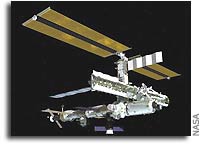A Treasure of Knowledge Now Aavailable at NASA’s New Space Station Science Web Site

By Lori Meggs
Want the latest space station science news? Then look no further than your Internet browser. NASA’s new International Space Station science Web site, created and managed by the Marshall Center’s Office of Strategic Analysis and Communications, Public and Employee Communications Office, is now live.
The site at www.nasa.gov/mission_pages/station/science/index.html went live this month.
You can mine a treasure of knowledge about Expedition 13 — the current, 13th mission to the station. You’ll find extensive information and fact sheets on science payloads and experiments crewmembers are performing — ranging from manufacturing new materials in space to how plants are grown.
The new site also will prove a useful resource for information about previous missions, with content from the former space station science Web site, and links to completed science experiments. Also available are lists of published papers and summaries of science experiment results, including information about crew health, findings about microgravity’s effect on the human body and ways that information is a treasure of knowledge now available at NASA’s new space station science Web site leading to advances in medicine on Earth.
“This Web site is specifically intended as a news media resource,” said Lybrease Woodard, project manager for the Payload Operations Integration Function in the Mission Operations Laboratory in Marshall’s Engineering Directorate. “And the public will find valuable information as well. We’re pleased this is available as an easily accessible new resource for those who want to learn about the work we’re accomplishing on the International Space Station.”
To aid in NASA’s mission to inspire the next generation of explorers, the site features information for students about educational experiments on the station. These include Educational Payload Operations, designed to teach students about the space environment, and EarthKAM, an experiment that allows students to pick sites anywhere in the world to photograph using a camera mounted in a station window.
Visitors to the site can view some of the students’ photos snapped from the orbiting lab. And there’s a link to “Saturday Science,” programs videotaped for use in classrooms, and NASA educational products that featured astronaut Don Pettit during his mission to the station in 2003. Pettit shows students how everyday items such as water and honey act differently in space. Among its new features, the Web site allows visitors to discover, through specific science and engineering examples, how space station experiments are contributing to the Vision for Space Exploration. The Vision calls for space shuttles to return to safe fl ight to complete the International Space Station, and for the continued human and robotic exploration of the solar system.
“The space station is now a stepping stone to the future,” said Julie Robinson, NASA’s deputy program scientist for the International Space Station at the Johnson Space Center in Houston. “Results from experiments performed on the station are what will lead us to long-term exploration. You’ll see our progress on this exciting Web site.”
A strength of the Web site is a dynamic format that links to weekly overviews of science on the space station, and allows updating of results and accomplishments as they happen.
NASA’s Payload Operations Center at Marshall coordinates all U.S. science activities on board the space station.
The writer, an ASRI employee, supports the Office of Strategic Analysis and Communications.









